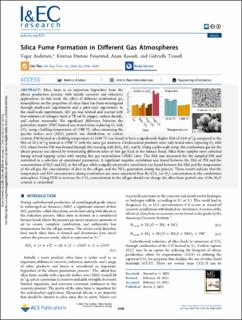| dc.description.abstract | Silica fume is an important byproduct from the silicon production process, with mainly concrete and refractory applications. In this work, the effect of different combustion gas atmospheres on the properties of silica fume has been investigated through small-scale experiments and a pilot-scale experiment. In the small-scale experiments, SiO gas was formed and reacted with four mixtures of nitrogen fixed at 79 vol %, oxygen, carbon dioxide, and carbon monoxide. No significant difference between the particulate matter (PM) formed was found when replacing O2 with CO2 using a holding temperature of 1700 °C, when measuring the specific surface area (SSA), particle size distribution, or carbon content. PM formed at a holding temperature of 1650 °C was found to have a significantly higher SSA of 32.9 m2/g compared to the SSA of 22.3 m2/g formed at 1700 °C with the same gas mixtures. Condensation products were only found when replacing O2 with CO, where brown PM was formed through SiO reacting with SiO2, SiC, and Si. Using a pilot-scale setup, the combustion gas for the silicon process was altered by recirculating different ratios of flue gas back to the furnace hood. Silica fume samples were collected during several tapping cycles with varying flue gas recirculation (FGR) rates. The SSA was measured for the sampled PM and correlated to a selection of operational parameters. A significant negative correlation was found between the SSA of PM and the concentration of H2O and SO2 in the off-gas, while a significant positive correlation was found between the SSA and the temperature of the off-gas, the concentration of dust in the off-gas, and the NOX generation during the process. These results indicate that the temperature and SiO concentration during combustion are more important than the CO2 (or O2) concentration in the combustion atmosphere. Using FGR to increase the CO2 concentration in the off-gas should not change the silica fume particle size, if the H2O content is controlled. | en_US |

